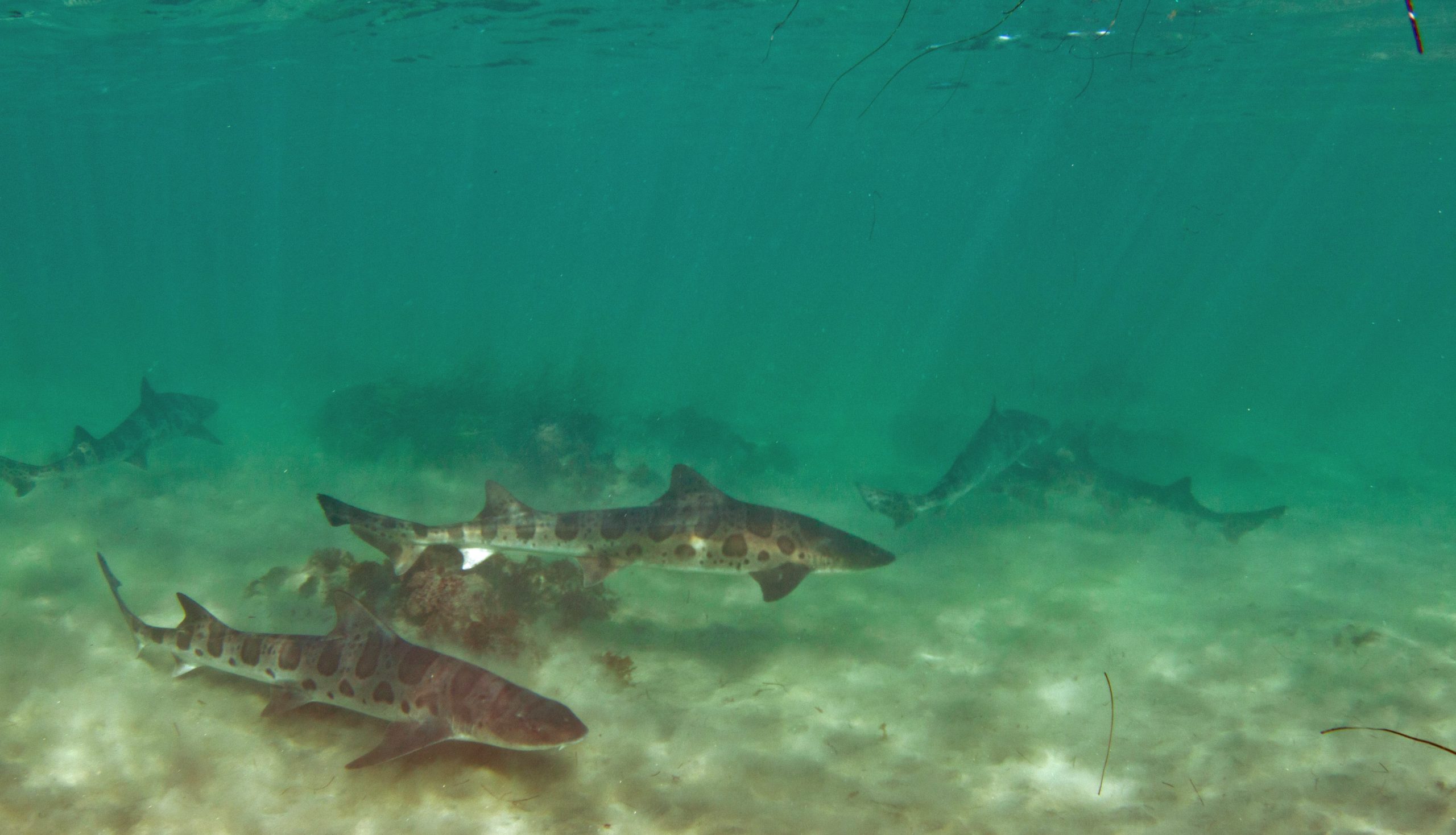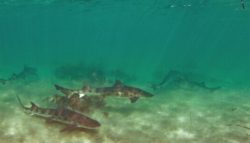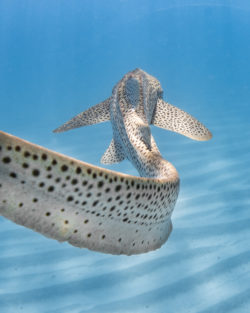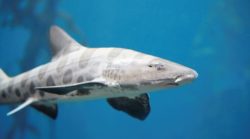
Sea Wonder: Leopard Shark

A shiver (or group) of leopard sharks swims in Monterey Bay National Marine Sanctuary. Leopard sharks spend much of their time near the sea floor, feeding on animals like crabs, clams, and small fish. Photo: Adam Obaza/NOAA
The leopard shark (Triakis semifasciata) is more fish than cat, though these members of the hound shark family have beautifully patterned skin that resembles a leopard’s spots. These spots aren’t just for show – they are an evolutionary adaptation that helps these sharks blend into their surrounding environments.
Description
Leopard sharks are medium-sized sharks with long, slender bodies and broad but short snouts. They can grow to weigh around 22 pounds and reach lengths between four and seven feet, though the average is around five. Females are usually larger than males but otherwise look similar. They have silvery-beige skin covered in dark brown and black saddle marks that resemble a leopard’s spots and their bellies are much lighter than their backs. Within their broad mouths are sharp-edged teeth that they replace throughout their lifetimes.
Their pectoral fins are wide and triangular, and they have two dorsal fins along their backs. The first dorsal is toward the front of the body and is rounded at its edges, the second is about halfway down the back, a pointier shape, and about 25 percent smaller than the first fin. Their tail is one of the species’ notable features as it is long and tapered, and the sideways swishing motion they use to move through the water creates an interesting visual.
Diet & Habitat

Leopard Shark. Photo: Jake Wilton/Coral Reef Image Bank
Leopard sharks aren’t picky, though they are strict carnivores. Their diet is mostly composed of food that lives on the seafloor or is attached to rocks and other features, including crustaceans, octopus, bony fishes, fish eggs, and worms and other invertebrates. They are known as opportunistic feeders, which means they will eat whatever is easiest to find and swallow it whole. To hunt, leopard sharks may use their patterned skin to help them hide and strike when unsuspecting prey swims by, or they will use their snouts to shovel the sediment on the seafloor and reveal buried critters. How do they find hidden prey? Using electromagnetic receptors near their mouths to detect electromagnetic waves produced by living, moving organisms.
Leopard sharks spend most of their lives near the seafloor and often rest on sandy areas of the seafloor. We commonly find them in shallow coastal waters, especially near bays and estuaries. They can survive in open ocean waters at depths of nearly 300 feet, but most often we see them in shallower areas at depths of between 15 and 30 feet. They can live near kelp forests or in rocky nearshore areas. They are not migratory but do often travel impressive distances of up to 100 miles from their home areas as food availability changes.
These sharks are found on America’s West Coast, usually ranging from Oregon down to the Gulf of California in Mexico. In the National Marine Sanctuary System, we see them living in or near all of the sanctuaries along the west coast.
Life History
Leopard sharks can live to be about 30 years old and we can use the appearance of their spots to estimate how old an individual is. The older the shark, the paler the interior portions of the spots appear. They are part of the hound shark family, which are known for their strong swimming abilities, the presence of two dorsal fins, and ovular eyes, each covered by a translucent eyelid.
Leopard sharks can live independently or in groups of the same or mixed species. We do often see them in large, nomadic schools of leopard sharks, dogfish, and smooth-hound sharks. Spawning occurs between March and June when food is most plentiful and environmental conditions are right. This species does not mate with the same partner ever year, but instead chooses a new one each season and individual males mate with many females each season.
These sharks are ovoviviparous, meaning eggs are fertilized internally and are incubated by the female as they develop. The eggs hatch while still inside of their mother’s oviducts and remain there until they are mature enough to survive the outside world. As individual pups grow, they will sometimes eat other embryos or unfertilized eggs in the womb. Females give birth to live pups and a single litter can range from four to 29 individual pups.
Leopard sharks reach sexual maturity when each individual achieves their maximum body size. For males, this occurs at around seven years of old and for females about 10. Like most sharks, they breed at a later age than most bony fish, are slow growing throughout their lifespans, and bear few young compared to other fish species. Understanding the life stages and reproductive productivity of a species is helpful to scientists and managers who want to evaluate current and future risks to population health.
Threats & Conservation
Leopard sharks are listed as a species of least concern by the International Union for Conservation of Nature (IUCN) as it is not a species that is currently at high risk of population decline or extinction. However, they are a popular sport fish target and part of the West Coast’s commercial shark fishery. Their slow reproductive rate and life cycle do make them vulnerable to overfishing. Other threats to the species include physical and chemical pollution, climate change and ocean acidification, habitat loss, and coastal development.

